This is the fifth part of a series of blog entries on a gift I got from Matt Heusser. Today, I’m heading for tying together all the loose ends.
I was too lazy in the last entry to upload an update of the mindmap I created. In order to head for the final testing where I get together all the loose ends, I need to consider it, though. Here is the latest mindmap after the fourth part.
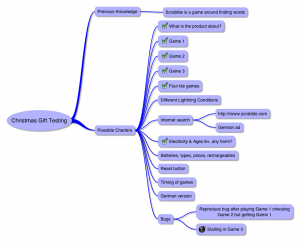
I was planning to go for the timing, and take a closer look on the inner parts. Let’s start with timing – just in case I can’t figure how to assemble the tiles after tearing them apart. Yesterday I found out that my old stop watch from my swim trainer time was out of batteries. So I had to use my iPhone. This means that it will have less precision as I could have with a stop watch.
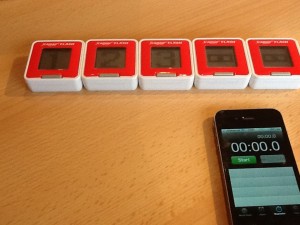
For game 1 I measured a total time of one minute fifteen seconds when you don’t do anything.
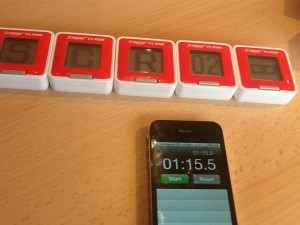
The manual claims that it adds five more seconds each time you find a five letter word. I validated that with one five letter word. Sorry, didn’t take the time for the randomness to work for my advantage and validate it with two or three five letter words.
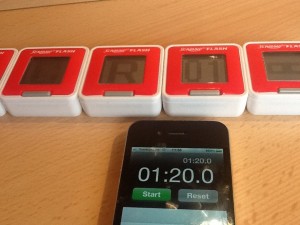
I went next to game 2. While trying to do so, I could reproduce the bug from my first actual test session. I decided to investigate it a bit more. It turns out that while you see the summary from the previous game, and press the button on the tiles with the 1, 2, or 3 on it, you might get into another game of the previous game. Timing is crucial here. If you press the button just when the summary will be displayed again, you can find yourself in the previous game despite the game you intended to choose. This seems to happen more frequently when your batteries got lower and lower on power, as the reaction time of the tile increases dramatically. I reproduced this also with the change from game 2 to game 1 while digging deeper. I also raised my priority for different lightning conditions, maybe even in combination with lower battery power. But this won’t be part of my current mission.
Really jumping to game 2 I measured one minute thirty seconds for the initial round.
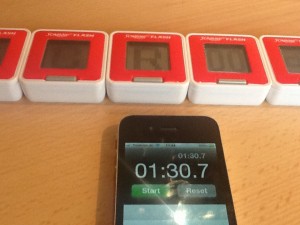
When you re-arrange and re-arrange more and more five letter word, your time will decrease. In between I measured roughly one minute.
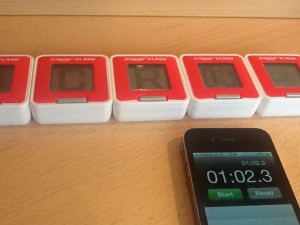
I didn’t go deeper in the differences between each round like I did for game 3. This was mainly caused by a problem I noticed. I had just re-arranged a five letter word, just before time was up. Then the timer started to tick down, the tiles blinked to indicate I formed a correct word, and the game was over. This seems to indicate that I got one minute thirty overall, rather than having some time for each five letter word. The manual does not state it like that. I was a bit confused, but noted this thing for a future session, maybe.
For game 3 I could reproduce my timings from yesterday. That is you get roughly 20 seconds for the first word, then it decreases by roughly one second each round. Nothing interesting.
Now, on to the next part. I was really curious about disassembling the tiles – finally some destruction. I was also curious whether I could reprogram the tiles. There was a German version of the game, so there must be something like that. Also, for game 1 it seemed to have some memory about the words you already formed. So, how does one tile look from the insight? Oh, one final thought before going for destruction: What about children taking the toy in their mouth? Was it water-proof? Let’s see.
One piece of advice before we get started. I disassembled one piece unsure whether I will be able to re-assemble it afterwards. I did play around with electronic devices when I was younger, so I seemed a bit confident. Don’t try this at home for yourself, kids. You might either destruct your game, or burn your house down – maybe. :)
Now, let’s see. The manual states that I need a screw-driver to replace the batteries.
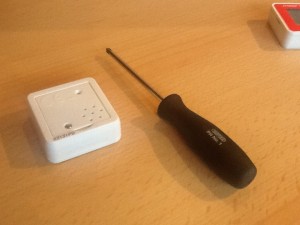
After opening the cover, I see two additional screws. So far there just seems to be the battery in there, nothing that really interests me. So, I continue to remove the two screws.
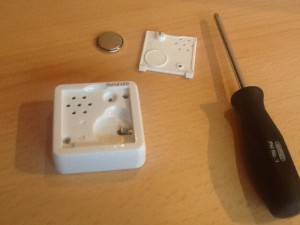
After tearing the tile into pieces, I see one main board, the button on the front has an additional plastic piece there, and I found two springs – unsure where they were originally placed.
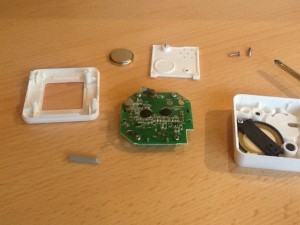
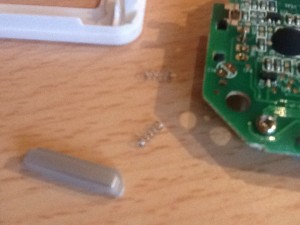
I see four additional screws on the main board holding a cover for the display. It seems that there is some protection for the display so that little fingers won’t crush the LCD. I remove that one as well.
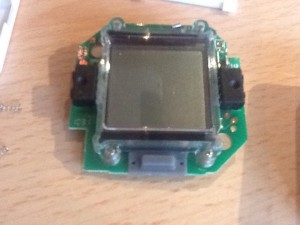

I start to explore the pieces I can recognize. The black pieces to the left and right from the display are the optical (I suppose) connectors to interact with the other four tiles. The board has some interesting stuff in there, but nothing I can recognize on my own. I can’t recognize a programmable interface here, and I don’t see memory, but I am quite certain that it’s too tiny for me to spot.
The connectors for the battery are not soldered with the board. I can remove them and place them back again. I really hope that I didn’t screw up the piece now. I’ll see.
I reassemble the tiles. The two springs seem to fit to the sound chip on the back panel. After putting all the screws back in, I try out the game, and still seems to work. Phew.
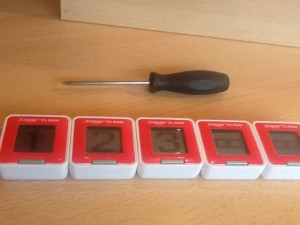
Tearing this piece apart didn’t reveal any new dramatically information to me. But I learned some bits about the tiles, and what safety functions the inventor put into place. It doesn’t seem to be water-proof. That’s maybe why it’s for ages eight and above.
Debriefing
So far, I have spent roughly two hours with the tiles. Another two hours for the write-ups. The game seems interesting, but also contains some inconsistencies. I saw one or two bugs there, one I couldn’t really reproduce. There is still some testing open for the tiles, but I’ll leave this to the ambitioned reader of my blog. I’d love to read about your approach if you do so.
The game seems to be ok for English speaking kids, but not so likely for foreign kids – even as an adult I had difficulties finding the words. If this is to provide a unique challenge for the game, it might be ok. The three different variants are also quite interesting, but in the long-run I don’t expect much curiosity about it. There is just one multiplayer game, that’s it. considering todays game consoles, kids might get bored pretty well. The tactile nature of the game, though, is a contrast to TV or computer games. For more multiplayer games, it would be interesting to combine two or three games to yield a bigger game with ten to fifteen letter words. Another dimension could be for kids to collect tiles, and yield more and more different variations. For example making explicit that you win one tile if you win the multiplayer game, then you could start collecting the pieces just as kids use to collect yugioh cards, or whatever is in fashion in your local area.
I hope you enjoyed this series. Looking forward to your thoughts and notes on it.




One thought on “A Christmas gift from a tester for a tester – Part Five”